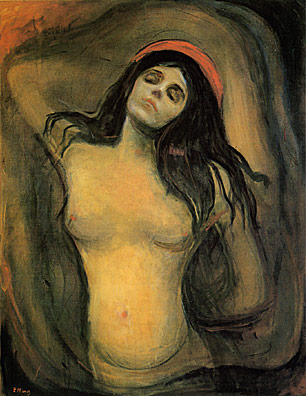"We should no longer paint interiors with men reading and women knitting.
We should paint living people who breathe, feel, suffer and love."
E. Munch

Spring (1889)
This picture shows the whole absurdity and cruelty of life. There is so much light and breeze coming through the window, filtering through and swelling the curtains, filling the entire room. The light, the breeze and the flowers all symbolize life. The spring itself is one of the most important symbols of life. Against this background of light and strength, the girl seems frail, weak and helpless. She is not looking at the window, she seems already resigned to her fate. The girl is dying although everything outside is coming to life. We will all die like this one day in a world throbbing with life. We won't be able to scream anymore and the nature will follow its course as if we never existed.

Night in Saint Cloud, 1890
The work painted by Munch after his father's death. Lonliness, sadness, the time stands still, it's quite and gloomy, the part of inner world passed away with the love one.

Death in the sickroom (1893)
In this work Munch came closest to fulfilling his ambition to produce paintings which would make people feel 'the sanctity of this moment and take off their hats as if they were in church'. With no prior knowledge of the title the spectator would be aware that something terrifying and tragic had happened. But unlike The Sick Child in which attention is drawn to the fate of the invalid herself, in this painting attention is drawn to the effect of death on the living. We do not see the face of the dying girl who is seated in the chair; instead we look into the faces of those who will survive her. Even though it is a group image, it is a picture of alienation as each individual must deal with death on his or her own terms. The image is very silent, with death expressed as an emotional void--the presence of an absence. Each family member is depicted in isolation from the others; each reacts in an individual way to the tragedy taking place.

Death in the Sickroom, 1896 Litograph

By the Deathbed (1893, pastel on paper)
In "By the deathbed" Munch daringly presented the
scene as if from the point of view of the dying girl, so that
the wall, the shadow on it, and the frieze- like group of
mourning relatives waver as through in delirium. Illness is
used as a metaphor of visionary insight.

By the Deathbed (1895)
.bmp)
By the Deathbed, 1896 (litograph)

Death and the Maiden, 1893
In "Death and the Maiden" its not skeletal image of
death, which is aggressor, but the young woman who
actively embraces the feeble bones of death. She is seeking
the consummation of her desires, so that new life,
symbolised by sperm and embryos, can take form.

The Dead Mother

The Dead Mother and Child, 1897-9

Death of
Marat I (1907)

The Drunken Boy, 1908
 Domestic Scene, Los Angeles 1963
Domestic Scene, Los Angeles 1963 Man Taking Shower in Beverly Hills, 1964
Man Taking Shower in Beverly Hills, 1964 Portrait of Nick Wilder, 1966
Portrait of Nick Wilder, 1966 The Room, Manchester Street, 1967
The Room, Manchester Street, 1967





.bmp)
+MADISON+SQUARE.bmp)




.bmp)


















.bmp)





 The Scream (1893)
The Scream (1893)

.bmp)

 The Woman in Three Stages (1894)
The Woman in Three Stages (1894) 




